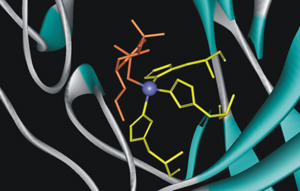|
|
BAPPL–Z server
|
|

Carbonic Anhydrase complexed with Ligand and Zinc ion (1cil)
|
Welcome to the BAPPL-Z server |
Binding Affinity Prediction of Protein-Ligand complex containing Zinc [ BAPPL-Z ] server computes the binding free energy of a zinc containing metalloprotein-ligand complex using an all atom energy based empirical scoring function [1], [2] & [3].
BAPPL-Z server provides two methods as options.
Method 1 : Input should be an energy minimized zinc containing metalloprotein-ligand complex, minimized using a dielectric of 1. The input complex should have hydrogens added and protonation states assigned. RESP charges should be assigned to the protein atoms and Mulliken charges to the ligand and the zinc ion. Stote & Karplus van der Waals parameters should be assigned to the zinc ion. Amber and GAFF force field van der Waals parameters should be assigned to the protein and the ligand atoms respectively. The server directly computes the binding affinity of the input complex using the scoring function [1] employing a sigmoidal dielectric for electrostatics I and dielectric of 80 for electrostatics II calculation.
Method 2 : Input should be an energy minimized zinc containing metalloprotein-ligand complex, minimized using a sigmoidal dielectric. The input complex should have hydrogens added and protonation states assigned. RESP charges should be assigned to the protein, ligand and the zinc ion. Stote & Karplus van der Waals parameters should be assigned to the zinc ion. Amber and GAFF force field van der Waals parameters should be assigned to the protein and the ligand atoms respectively. The server directly computes the binding affinity of the input complex using the scoring function [1] employing a sigmoidal dielectric for electrostatics I and II calculation.
For format specifications on the input, please refer to the README file.
For the purpose of validation of the empirical scoring function [1] a dataset of 90 zinc containing metalloprotein-ligand complexes has been prepared. Click here to access the Metalloprotein-Ligand Complex Dataset.
|
|
BAPPL-Z server |
|

